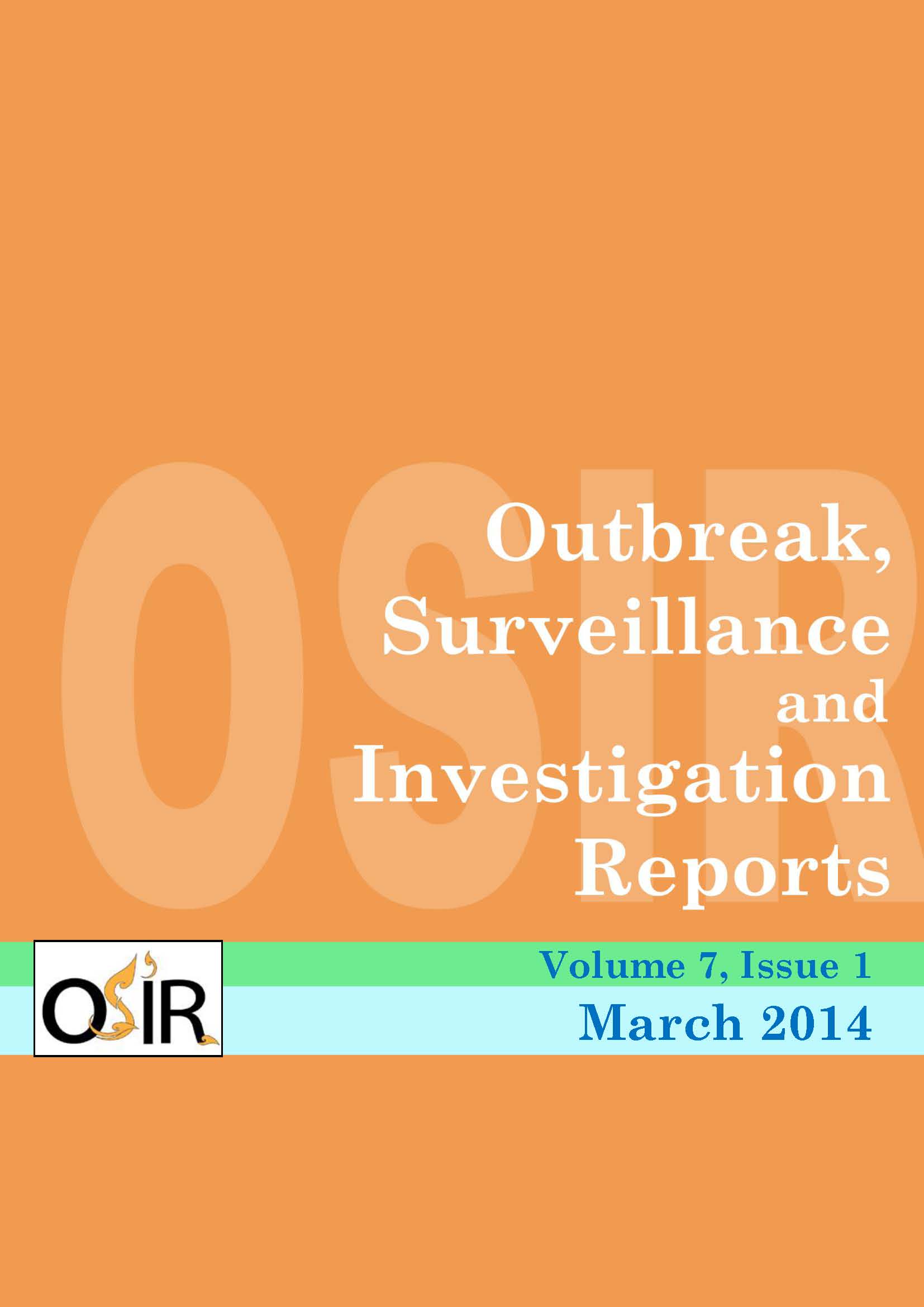Flood-related Outbreak of Peripheral Neuropathy among Prisoners in Bangkok, Thailand
DOI:
https://doi.org/10.59096/osir.v7i1.263293Keywords:
peripheral neuropathy, arsenic, prisoners, outbreak, ThailandAbstract
During 9-20 Nov 2011, four prisoners in the national prison died with unknown cause and many prisoners developed diarrhea and neuropathy. The Bureau of Epidemiology launched an investigation to identify etiology and source of outbreak, and implement control measures. A case was defined as a prisoner or guard who developed gastrointestinal (GI) symptoms or neurological symptoms during 1 Sep to 31 Dec 2011. Foods, water, blood and urine samples were tested for heavy metals, vitamins B1 and B12. The prison had 33 guards, 3,668 male prisoners and 555 female prisoners. Among 475 prisoners who met the case definition, 307 (64.6%) GI cases, 49 (10.3%) neurological cases and 119 (25.1%) cases with both GI and neurological symptoms were identified. No case was found among the guards. Attack rates among male and female prisoners were 12.6% (462/3,668) and 2.3% (13/555) respectively. No female prisoners developed neuropathy. Eleven male prisoners had severe distal symmetrical peripheral neuropathy. Four men aged 26-47 years died after developing acute dyspnea. The cases rapidly increased after pipeline of the prison damaged on 2 Nov 2011. Blood and urine samples illustrated vitamin B1 deficiency and high arsenic concentration respectively. This outbreak of peripheral neuropathy possibly resulted from arsenic contaminated drinking water. After providing clean water on 24 Nov 2011, the outbreak subsided within 10 days.
References
Piyaphanee W, Olanwijitwong J, Kusolsuk T, Silachamroon U. Awareness, practices, and health problems of backpackers traveling during flooding in Thailand during 2011. Southeast Asian J Trop Med Public Health. 2012 Sep;43(5):1193-200.
Rajaković LV, Marković DD, Rajaković-Ognjanović VN, Antanasijević DZ. Review: the approaches for estimation of limit of detection for ICP-MS trace analysis of arsenic. Talanta. 2012 Dec 15;102:79-87. Epub 2012 Aug 21.
Agency for Toxic Substances and Disease Registry. Cadmium. 2011 Mar 3 [cited 2012 Oct 26]. <http://www.atsdr.cdc.gov/substances/toxsubstance.asp?toxid=15>
Pearce JM. Burton's line in lead poisoning. Eur Neurol. 2007;57(2):118-9. Epub 2006 Dec 18.
Scott TF, Shah SM. Neurological examination. In: Shah SM, Kelly KM, editors. Principles and practice of emergency neurology: handbook for emergency physicians. Cambridge: Cambridge University Press; 2003. p.7-8.
Vitamins of the B complex. Br Med J. 1968 Dec 14;4(5632):690-1. [cited 2012 Oct 26]. <http://www.ncbi.nlm.nih.gov/pmc/articles/PMC1912760/?page=1>
Agency for Toxic Substance and Disease Registry. Case studies in environmental medicine: arsenic toxicity. 2011 Oct 1 [cited 2012 Oct 26]. <http://www.atsdr.cdc.gov/csem/csem.asp?csem=1&po=1>
Singh AP, Goel RK, Kaur T. Mechanisms pertaining to arsenic toxicity. Toxicol Int. 2011 Jul;18(2):87-93.
Gorby MS. Arsenic poisoning. West J Med. 1988 Sep;149(3):308-15.
Peters RA, Sinclair HM, Thompson RH. An analysis of the inhibition of pyruvate oxidation by arsenicals in relation to the enzyme theory of vesication. Biochem J. 1946;40(4):516-24.
Ross R, Reynolds ES. A case of Beri-Beri (?) possibly due to arsenic poisoning. Br Med J. 1901 Oct 5;2(2127):979-80.
Hockaday TDR. Hockaday JM, Rushworth G. Motor neuropathy associated with abnormal pyruvate metabolism unaffected by thiamine. J Neurol Neurosurg Psychiatry. 1966 Apr; 29(2): 119-28.
World Health Organization. Thiamine deficiency and its prevention and control in major emergencies. 1999. [cited 2012 Oct 26]. <http://whqlibdoc.who.int/hq/1999/WHO_NHD_99.13.pdf>
Neurological disorders associated with malnutrition. In: World Health Organization. Neurological disorders: public health challenges. Geneva: World Health Organization; 2006. p.111-26.
Lab Test Onlines. Malnutrition. 2013 Apr 19. [cited 2012 Oct 26]. <http://labtestsonline.org/understanding/conditions/malnutrition/>
Esch T, Stefano GB, Fricchione GL, Benson H. The role of stress in neurodegenerative diseases and mental disorders. euro Endocrinol Lett. 2002 Jun;23(3):199-208.
Heymann DL. Control of communicable diseases manual. 19th ed. Baltimore: American Public Health Association; 2008.
Agency for Toxic Substance and Disease Registry. Toxicological profile for arsenic. 2007 Aug. [cited 2012 Oct 26]. <http://www.atsdr.cdc.gov/toxprofiles/tp2.pdf>
Gensheimer KF, Rea V, Mills DA, Montagna CP, Simone K. Arsenic poisoning caused by intentional contamination of coffee at a church gathering--an epidemiological approach to a forensic investigation. J Forensic Sci. 2010 Jul;55(4):1116-9.
Tanaka H, Tsukuma H, Oshima A. Long-Term prospective study of 6104 survivors of arsenic poisoning during infancy due to contaminated milk powder in 1955. J Epidemiol. 2010 Aug 21. [Epub ahead of print].
Ratnaike RN. Acute and chronic arsenic toxicity. Postgrad Med J. 2003 Jul;79(933):391-6.
Schoolmeester WL, White DR. Arsenic poisoning. South Med J. 1980 Feb;73(2):198-208.
Hughes RA. Peripheral neuropathy. BMJ. 2002 Feb 23;324(7335):466-9.
Martyn CN, Hughes RA. Epidemiology of peripheral neuropathy. J Neurol Neurosurg Psychiatry. 1997 Apr;62(4):310-8. [cited 2012 Oct 26]. <http://www.ncbi.nlm.nih.gov/pmc/articles/PMC1074084/pdf/jnnpsyc00004-0006.pdf>
Poncelet AN. An algorithm for the evaluation of peripheral neuropathy. Am Fam Physician. 1998 Feb 15;57(4):755-64.
Robertson JM. The disease profile of Texas prison inmates. Ann Epidemiol. 2000 Feb;10(2):71-3.
Chen KT, Twu SJ, Chiou ST, Pan WH, Chang HJ, Serdula MK. Outbreak of beriberi among illegal mainland Chinese immigrants at a detention center in Taiwan. Public Health Rep. 2003 Jan-Feb;118(1):59-64.
Chen KT, Chiou ST, Chang YC, Pan WH, Twu SJ. Cardiac beriberi among illegal mainland Chinese immigrants. J Int Med Res. 2001 Jan-Feb;29(1):37-40.
Babashola Olubodun JO, Jaiyesimi AE, Fakoya EA, Olasode OA. Malnutrition in prisoners admitted to a medical ward in a developing community. BMJ. 1991 Sep 21;303(6804):693-4.
de Montmollin D, MacPhail J, McMahon J, Coninx R. Outbreak of beri-beri in a prison in West Africa. Trop Doct. 2002 Oct;32(4):234-6.
Ahoua L, Etienne W, Fermon F, Godain G, Brown V, Kadjo K, et al. Outbreak of beriberi in a prison in Côte d'Ivoire. Food Nutr Bull. 2007 Sep;28(3):283-90.
Downloads
Published
How to Cite
Issue
Section
License
Copyright (c) 2023 Outbreak, Surveillance, Investigation & Response (OSIR) Journal

This work is licensed under a Creative Commons Attribution-NonCommercial-NoDerivatives 4.0 International License.









